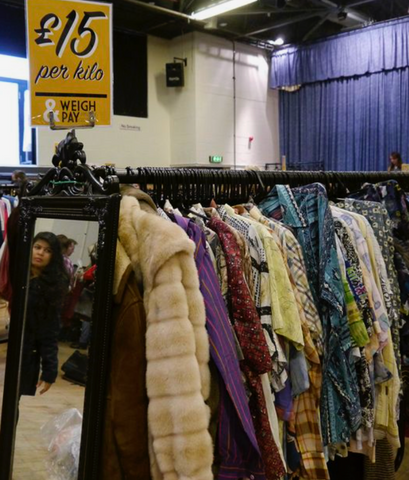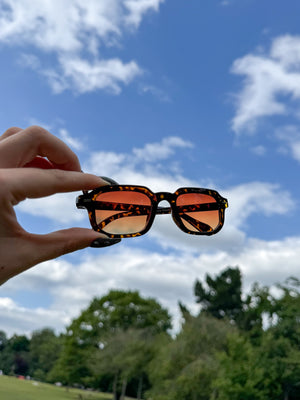
What's the Difference Between Charity Shops and Vintage Stores?
Posted by Chrisia Borda on
With the Second hand clothing market set to double the size of fast fashion by 2030 both charity and vintage stores are seeing a significant increase in customers. This is often pinned down to the fact you can find amazing, high quality pieces for less than you can find in most fast fashion and high-street stores. The second-hand and vintage market is quickly losing its stigma that it once held before.
The two options for second-hand clothing often get compared and contrasted. This is largely due to the infinite options to find that hidden gem you didn't know you needed. Subsequently making those bargains a lot harder to resist!
Whether you want new Y2K pieces or sunnies for the festival season and summer - there will definitely be a second-hand option that is perfect for your needs.
But a question often asked is what makes a high-street charity shop different from a vintage store?

What is the Main Difference?
The main difference often noted to differentiate the two is the selection of clothes stocked. Charities shops use donations as their main stock for their stores or transported from other stores across the country. The “good” pieces are picked and stocked on the shelves in the shop and a percentage put aside for their e-commerce.
Whereas vintage stores will specifically hand-pick their pieces from vintage wholesalers. The pieces bought for vintage stores are handpicked for their style, brand or longevity. This ensures each piece is classic and will be loved and reworn for their customer base.

Why are Prices Different Between the Stores?
Something to consider when shopping in either option are the varying price points they offer.
A charity shop can often be a little cheaper because they are not specialists in second-hand clothing and often funded by larger charities that have little to no margins or outgoings.
But at a vintage store each garment is handpicked by experts in vintage clothing and are classic. Furthermore, in order for a vintage store to survive they will have more outgoings and margins to adhere to. So that they can make a profit and continue to sell amazing high-quality pieces. Even with designer items that retain their value, each piece is bought and picked with customers in mind.
The Experience Factor?
As we spoke about earlier, the experience factor is often what differentiates your local charity shop to a vintage store.
Charity shops don’t have the same experience factor as vintage stores. The items in most charity shops are quickly checked for their condition and sorted by category. This is why it often takes a little longer to find items in charity shops as the items are not categorised or paired with suitable matching items.
The expertise that a vintage store brings is the expertise and the eye for a good piece via its buyers. Many buyers at vintage stores have been in the field for years so know the brands, pieces and sell-out pieces to look out for.
How These Shops And Stores Are Going Online
Charity shops have recently been looking into diversifying and are now using sites such as Depop, Vinted and Ebay to sell more individual pieces from their stock.
This was a move that started at the beginning of the pandemic but has quickly grown into a sustained portion of their sales. By using sites such as Ebay, this allowed them to try out a new and different way of reaching their customers.
However, this method may take a little longer to (virtually) sort through the catalogues of the varying different charity shops and resale sites. Using notifications and filters can be a great way on larger sites to narrow down a search for a particular item that you are looking for.It is also worth checking reviews or asking for dimensions of any items bought from online charity shops. What can often happen due to the volume of items donated at any one time details on the clothes can be missed. So it is worth asking and checking with the seller. It is also recommended to check for any marks or imperfections which should always be stated but similarly these can be missed sometimes too. These details are normally always noted by vintage sites and stores.
But it is not just charity shops that have been going online. During the pandemic many vintage stores (if they already were not) went online to bring in their customers. They did this via their websites, IG shops or through virtual selling on their stories.We have found that this can also mean that items may sell out a little faster too.
We are now seeing more and more specialist vintage stores doing this too. These sellers are best for when you want a specific item as they can often source items for their customers too. Although this expertise and service will come at a larger cost than most vintage stores.
Our Verdict?
We still believe that if you are looking for stand-out brands and one-off pieces, you cannot look anywhere other than a vintage or thrift store.
Vintage sites (such as Thrifted) offer the ability to find high-quality pieces but at a better affordability than others, because we want these pieces to be available and accessible to everyone. Not to mention using online vintage sites can be much easier by using tools such as filters to narrow down your search for the perfect item.
When purchasing from either outlet, consider the expertise behind the pieces you would like to buy. Vintage stores are the best option for expertise for high-quality pieces that are unmatched in any charity shop online or in-person.
References:
Images via:





